light Citroen BERLINGO MULTISPACE 2016 2.G Owner's Guide
[x] Cancel search | Manufacturer: CITROEN, Model Year: 2016, Model line: BERLINGO MULTISPACE, Model: Citroen BERLINGO MULTISPACE 2016 2.GPages: 296, PDF Size: 10.36 MB
Page 99 of 296

97
Berlingo-2-VP_en_Chap04_Ergonomie_ed01-2016
SEATING AREA FITTINGS
Floor boxes
Two boxes are available, located under
the rear passenger footwells.
To
open them, slide your fingers into
the
recess and lift the lid.
Aircraft style tables
To put the table in place, pull it
upwards and fold it down.
a
s a safety precaution, above a high
pressure, the table is designed to
unhook.
To
put it back in place, with the table
vertical, engage one side then the
other
, forcing slightly.
Do
not place hard or heavy objects
on
the table.
They
could become
dangerous
projectiles in the event of
sharp
braking or impact.
A
bag hook is provided on the side of
each
table.
Side blinds
Side blinds may be available on the sliding side doors.
Pull the side blind by the tab to install it.
To avoid damaging the blind when opening the door, check that the tab is
hooked
securely.
a
lways guide the blind slowly
using the tab, both when raising
and
when lowering.
EASE OF USE and COMFORT
4
Practical information
Page 116 of 296

11 4
Berlingo-2-VP_en_Chap05_Securite_ed01-2016
HAZARD WARNING LAMPS
H
ORN
Press the centre of the steering wheel.
PARKING BRAKE
Applying
Pull the parking brake lever up to immobilise
your vehicle.
Check
that the parking brake is applied
firmly
before leaving the vehicle.Pull
on the parking brake lever, only
with the vehicle stationary.
In the exceptional case of use of the
parking
brake when the vehicle is
moving,
apply the brake by pulling
gently
to avoid locking the rear wheels
(risk
of skidding).
Press this button, the direction
indicators
flash.
They
can
operate
with
the
ignition
off.
The
hazard
warning
lamps
should
only
be used in dangerous situations, when
stopping
in
an
emergency
or
when
driving
in
unusual
conditions.
When
parking on a slope, direct your
wheels
towards the pavement and pull
the
parking brake lever up.
There is no advantage in engaging
a
gear after parking the vehicle,
particularly
if the vehicle is loaded.
If the parking brake is still on or has not been released properly, this is
indicated
by this warning lamp which
comes
on in the instrument panel.
Automatic operation of hazard
warning lamps
When braking in an emergency, depending on the force of deceleration,
the hazard warning lamps come
on
automatically.
They
switch off
automatically
the first time you
accelerate.
It
is also possible to switch them off by
pressing
the switch on the dashboard.Releasing
Pull the lever up slightly and press the
button to lower the parking brake lever.
driving safely
Page 120 of 296

ABS
ABS
11 8
Berlingo-2-VP_en_Chap05_Securite_ed01-2016
ANTI-LOCK BRAKING SYSTEM
(ABS / EBFD)
The ABS and EBFD (electronic brake force
distribution) systems improve the
stability
and manoeuvrability of your
vehicle
on braking, in particular on
poor
or slippery surfaces.
The
ABS
prevents locking of the
wheels, the EBF
d provides control of
the
braking pressure wheel by wheel.If
this warning lamp comes on,
accompanied by an
audible
signal and a message
in the screen, it indicates a
malfunction
of the
ABS
which
could result in a loss of control of the
vehicle
on braking.
If
this warning lamp comes
on,
together with the brake
and
STOP
warning lamps,
accompanied
by an audible
signal
and a message in the
screen,
it indicates a malfunction of
the
electronic brake force distribution
which could result in a loss of control of
the
vehicle on braking.
EMERGENCY BRAKING
ASSIST
ANCE (EBA)
In an emergency, this system enables the optimum braking pressure to be
reached
more quickly, press the pedal
firmly
without releasing it.
It is triggered by the speed at which the
brake
pedal is pressed down.
This
alters the resistance of the brake
pedal
under your foot.
To
maintain operation of the
emergency
braking assistance system:
keep
your foot on the brake pedal.
Good practice
The anti-lock braking system comes into operation automatically when
there
is a risk of wheel lock. It does not
reduce
the braking distance.
o
n very slippery surfaces (ice,
oil, etc...)
the
ABS
may increase the
braking
distance. When braking in
an
emergency, do not hesitate to
press
the brake pedal firmly, without
releasing the pressure, even on a
slippery surface, you will then be able
to
continue to manoeuvre the vehicle
to
avoid an obstacle.
Normal
operation of the
ABS
may be
felt
by slight vibration of the brake
pedal.
When changing wheels (tyres and
rims),
ensure that these are listed by
CITROËN
for the vehicle. Stop as soon as it is safe to do so.
In both cases, contact a CITR
o Ë n
dealer
or a qualified workshop.
driving safely
Page 128 of 296
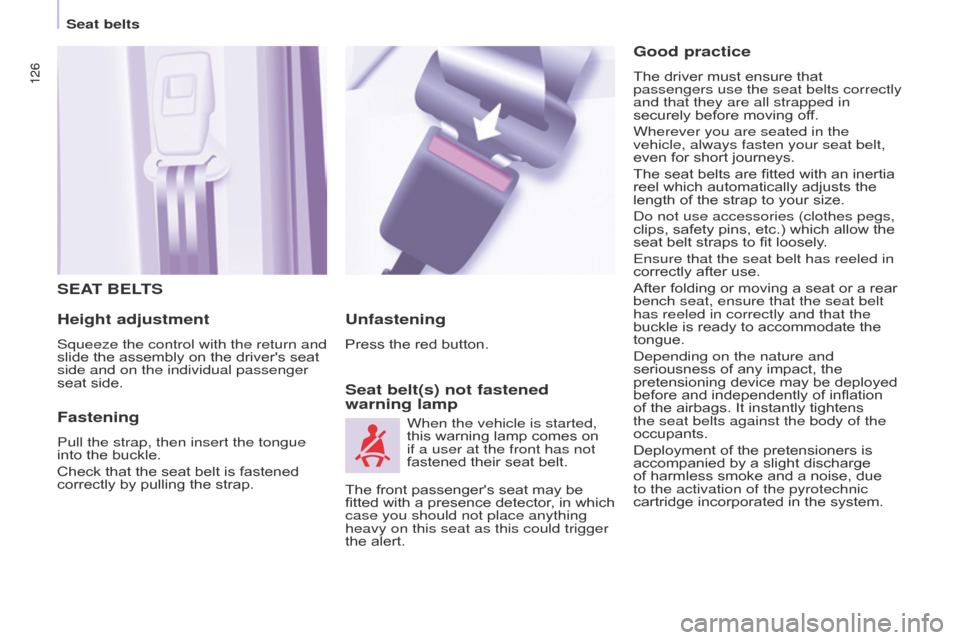
126
Berlingo-2-VP_en_Chap05_Securite_ed01-2016
126
SEAT BELTS
Height adjustment
Squeeze the control with the return and
slide the assembly on the driver's seat
side and on the individual passenger
seat
side.
Fastening
Pull the strap, then insert the tongue
into the buckle.
Check
that the seat belt is fastened
correctly
by pulling the strap.
Seat belt(s) not fastened
warning lamp Unfastening
Press the red button.
When the vehicle is started,
this
warning lamp comes on
if a user at the front has not
fastened
their seat belt.
Good practice
The driver must ensure that passengers use the seat belts correctly
and that they are all strapped in
securely before moving off.
Wherever you are seated in the
vehicle, always fasten your seat belt,
even
for short journeys.
The
seat belts are fitted with an inertia
reel
which automatically adjusts the
length
of the strap to your size.
d
o not use accessories (clothes pegs,
clips,
safety pins, etc.) which allow the
seat
belt straps to fit loosely.
Ensure that the seat belt has reeled in
correctly
after use.
After
folding or moving a seat or a rear
bench seat, ensure that the seat belt
has reeled in correctly and that the
buckle
is ready to accommodate the
tongue.
d
epending on the nature and
seriousness
of any impact, the
pretensioning
device may be deployed
before
and independently of inflation
of
the airbags. It instantly tightens
the seat belts against the body of the
occupants.
Deployment
of the pretensioners is
accompanied
by a slight discharge
of
harmless smoke and a noise, due
to the activation of the pyrotechnic
cartridge
incorporated in the system.
The
front
passenger's
seat
may
be
fitted
with
a
presence
detector
,
in
which
case you should not place anything
heavy on this seat as this could trigger
the
alert.
Seat belts
Page 132 of 296
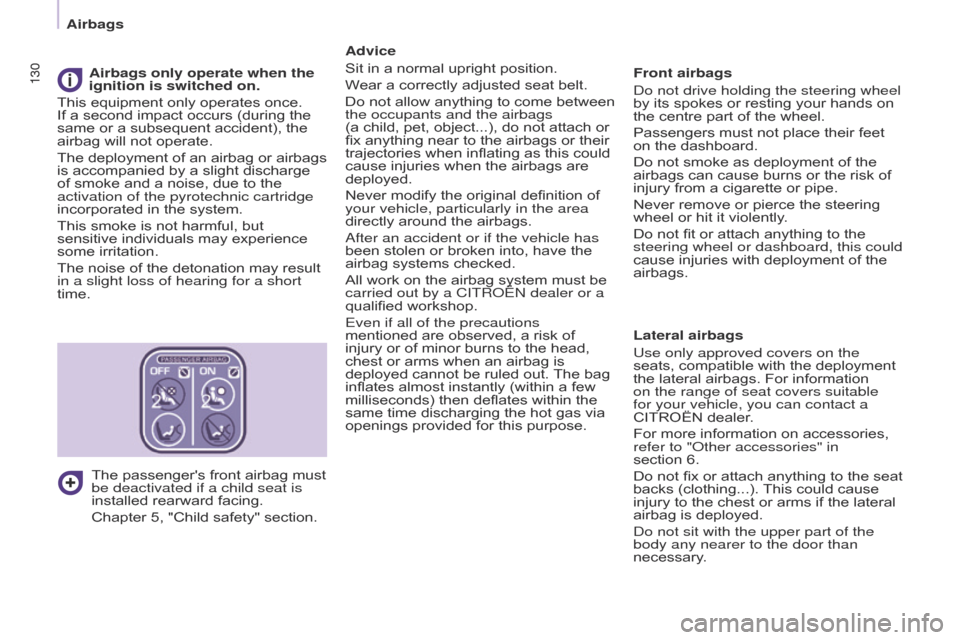
130
Berlingo-2-VP_en_Chap05_Securite_ed01-2016
130
Advice
Sit in a normal upright position.
Wear
a correctly adjusted seat belt.
Do
not
allow
anything
to
come
between
the occupants and the airbags
(a
child, pet, object...), do not attach or
fix
anything near to the airbags or their
trajectories
when inflating as this could
cause
injuries when the airbags are
deployed.
Never
modify the original definition of
your vehicle, particularly in the area
directly
around the airbags.
a
fter an accident or if the vehicle has
been
stolen or broken into, have the
airbag
systems checked.
All
work on the airbag system must be
carried out by a CITR
o Ë n dealer or a
qualified
workshop.
Even if all of the precautions
mentioned
are observed, a risk of
injury
or of minor burns to the head,
chest
or arms when an airbag is
deployed
cannot be ruled out.
The
bag
inflates
almost instantly (within a few
millis
econds) then deflates within the
same
time discharging the hot gas via
openings
provided for this purpose.Front airbags
d
o not drive holding the steering wheel
by
its spokes or resting your hands on
the
centre part of the wheel.
Passengers
must not place their feet
on
the dashboard.
Do
not smoke as deployment of the
airbags
can cause burns or the risk of
injury
from a cigarette or pipe.
Never
remove or pierce the steering
wheel
or hit it violently.
Do
not fit or attach anything to the
steering wheel or dashboard, this could
cause
injuries with deployment of the
airbags.
Lateral airbags
Use only approved covers on the
seats,
compatible with the deployment
the
lateral airbags. For information
on the range of seat covers suitable
for your vehicle, you can contact a
CITROËN dealer
.
For
more information on accessories,
refer to "
o ther accessories" in
section 6.
Do
not fix or attach anything to the seat
backs
(clothing...).
This
could cause
injury
to the chest or arms if the lateral
airbag
is deployed.
d
o not sit with the upper part of the
body any nearer to the door than
necessary.
Airbags only operate when the
ignition is switched on.
This
equipment
only
operates
once.
If
a
second
impact
occurs
(during
the
same
or
a
subsequent
accident),
the
airbag
will
not
operate.
The
deployment
of
an
airbag
or
airbags
is
accompanied
by
a
slight
discharge
of
smoke
and
a
noise,
due
to
the
activation of the pyrotechnic cartridge
incorporated
in
the
system.
This
smoke
is
not
harmful,
but
sensitive
individuals
may
experience
some
irritation.
The
noise
of
the
detonation
may
result
in a slight loss of hearing for a short
time. The
passenger's
front
airbag
must
be deactivated if a child seat is
installed
rearward
facing.
Chapter
5,
"Child
safety"
section.
airbags
Page 153 of 296
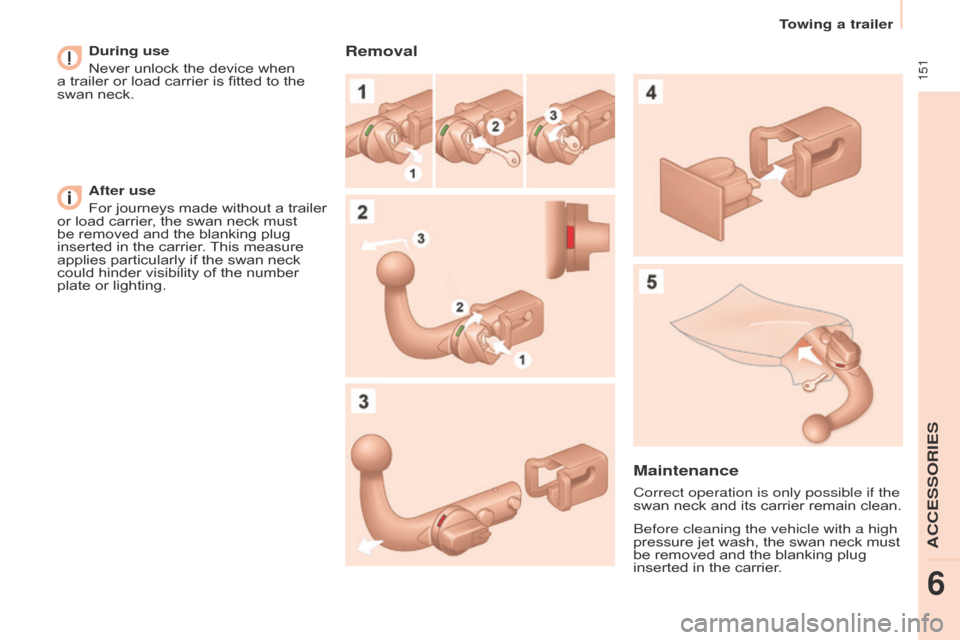
151
Towing a trailer
Berlingo-2-VP_en_Chap06_accessoire_ed01-2016
During use
Never unlock the device when
a
trailer or load carrier is fitted to the
swan
neck.
After use
For
journeys
made
without
a
trailer
or
load carrier, the swan neck must
be
removed and the blanking plug
inserted
in the carrier.
This
measure
applies
particularly if the swan neck
could
hinder visibility of the number
plate
or lighting.Removal
Maintenance
Correct operation is only possible if the
swan neck and its carrier remain clean.
Before cleaning the vehicle with a high
pressure
jet wash, the swan neck must
be
removed and the blanking plug
inserted
in the carrier.
aCCESSoRIES
6
Page 156 of 296

154
Berlingo-2-VP_en_Chap07_Verification_ed01-2016
OPENING THE BONNET
Bonnet stay
Secure the stay in its location,
identified by a sticker on the right-hand
side of the vehicle, to hold the bonnet
open.
Before closing the bonnet, put the stay
back
in its clip without using excessive
force.
On the outside
Raise the bonnet slightly by reaching
in a flat hand, palm down, to make
access
to the lever easier.
With this hand, push the safety catch
to
the left. Raise the bonnet.
On the inside
Pull the lever below the dashboard
towards you. The bonnet is released.
To close
Lower the bonnet and release it at the
end of its travel. Check that the bonnet
is
secure.
avoid opening the bonnet in strong
winds.
opening the bonnet
Page 160 of 296
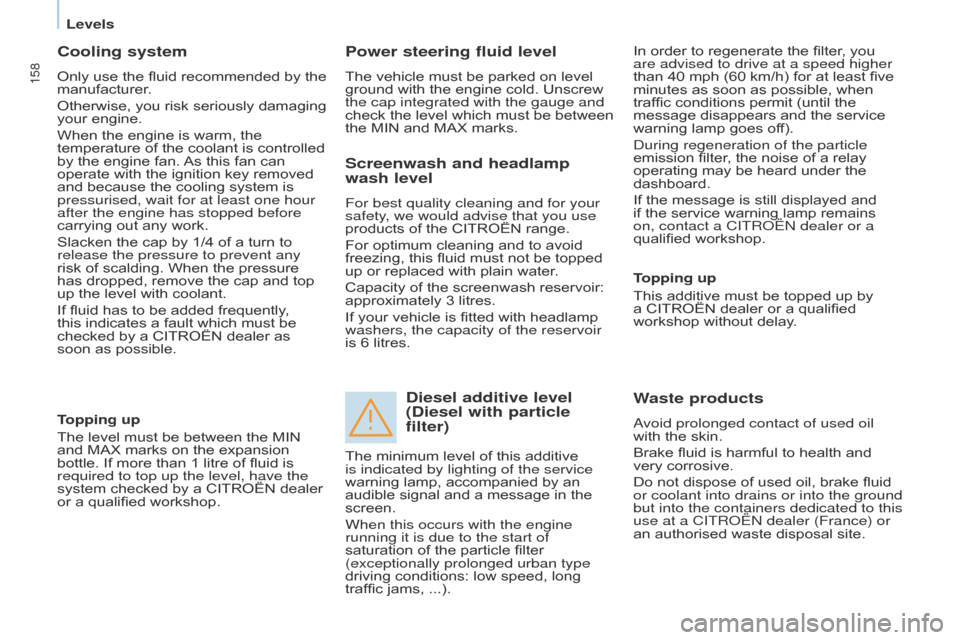
158
Berlingo-2-VP_en_Chap07_Verification_ed01-2016
Levels
Cooling system
Only use the fluid recommended by the manufacturer.
Otherwise,
you risk seriously damaging
your
engine.
When
the engine is warm, the
temperature
of the coolant is controlled
by
the engine fan.
As
this fan can
operate
with the ignition key removed
and
because the cooling system is
pressurised, wait for at least one hour
after the engine has stopped before
carrying
out any work.
Slacken
the cap by 1/4 of a turn to
release the pressure to prevent any
risk
of scalding. When the pressure
has
dropped, remove the cap and top
up
the level with coolant.
If
fluid has to be added frequently,
this
indicates a fault which must be
checked
by a CITROËN dealer as
soon
as possible.
Power steering fluid level
The vehicle must be parked on level ground with the engine cold. Unscrew
the cap integrated with the gauge and
check
the level which must be between
the
MIN and MAX marks. In
order to regenerate the filter, you are advised to drive at a speed higher
than
40 mph (60 km/h) for at least five minutes
as soon as possible, when
traffic
conditions permit (until the
message
disappears and the service
warning
lamp goes off).
d
uring regeneration of the particle
emission
filter, the noise of a relay
operating
may be heard under the
dashboard.
If
the message is still displayed and
if
the service warning lamp remains
on, contact a CITR
o Ë n dealer or a
qualified
workshop.
Topping up
The
level
must
be
between
the
MIN
and
MAX
marks
on
the
expansion
bottle.
If
more
than
1
litre
of
fluid
is
required to top up the level, have the
system
checked
by
a
CITROËN
dealer
or
a
qualified
workshop.
Screenwash and headlamp
wash level
For best quality cleaning and for your
safety, we would advise that you use
products of the CITROËN range.
For
optimum cleaning and to avoid
freezing,
this fluid must not be topped
up
or replaced with plain water.
Capacity
of the screenwash reservoir:
approximately
3 litres.
If
your vehicle is fitted with headlamp
washers, the capacity of the reservoir
is
6 litres.
Diesel additive level
(Diesel with particle
filter)
Topping up
This additive must be topped up by
a
CITROËN dealer or a qualified
workshop
without delay.
Waste products
avoid prolonged contact of used oil
with the skin.
Brake
fluid is harmful to health and
very
corrosive.
Do
not dispose of used oil, brake fluid
or coolant into drains or into the ground
but into the containers dedicated to this
use at a CITR
o Ë n dealer (France) or
an
authorised waste disposal site.
The
minimum
level
of
this
additive
is indicated by lighting of the service
warning
lamp,
accompanied
by
an
audible
signal
and
a
message
in
the
screen.
When this occurs with the engine
running it is due to the start of
saturation
of
the
particle
filter
(exceptionally prolonged urban type
driving
conditions:
low
speed,
long
traffic
jams,
...).
Page 162 of 296
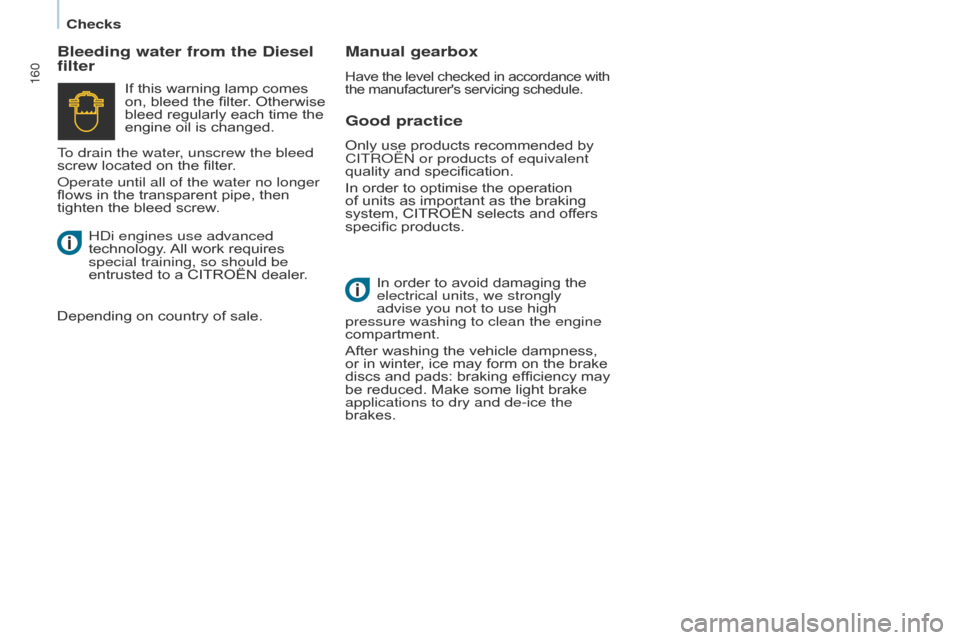
160
Berlingo-2-VP_en_Chap07_Verification_ed01-2016
Checks
Good practice
Bleeding water from the Diesel
filter
Manual gearbox
Have the level checked in accordance with the
manufacturer's servicing schedule.
In order to avoid damaging the electrical units, we strongly
advise you not to use high
pressure washing to clean the engine
compartment.
After
washing the vehicle dampness,
or
in
winter, ice may form on the brake
discs
and pads: braking efficiency may
be
reduced. Make some light brake
applications to dry and de-ice the
brakes.
If
this
warning
lamp
comes
on,
bleed
the
filter.
Otherwise
bleed
regularly
each
time
the
engine
oil
is
changed.
H
d
i engines use advanced
technology.
All
work
requires
special training, so should be
entrusted
to
a
CITROËN
dealer.
Depending
on
country
of
sale.
To drain the water, unscrew the bleed
screw
located
on
the
filter.
o
perate until all of the water no longer
flows
in
the
transparent
pipe,
then
tighten
the
bleed
screw.
Only use products recommended by
CITR
o Ë n or products of equivalent
quality and specification.
In
order to optimise the operation
of
units as important as the braking
system,
CITROËN selects and offers
specific
products.
Page 163 of 296
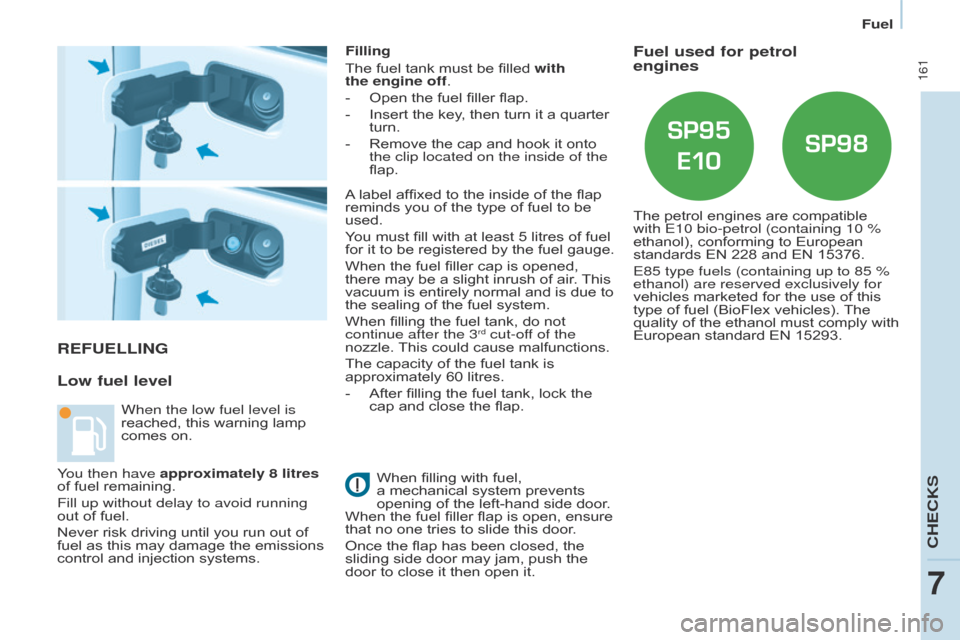
161
Berlingo-2-VP_en_Chap07_Verification_ed01-2016
Fuel
REFUELLING
Low fuel level
Filling
The fuel tank must be filled with
the
engine off.
-
Open
the fuel filler flap.
-
Insert
the key, then turn it a quarter
turn.
-
Remove
the cap and hook it onto
the clip located on the inside of the
flap.
When
filling with fuel,
a mechanical
system prevents
opening
of the left-hand side door.
When
the fuel filler flap is open, ensure
that
no one tries to slide this door.
Once
the flap has been closed, the
sliding
side door may jam, push the
door
to close it then open it.
When the low fuel level is
reached,
this
warning
lamp
comes
on. A
label affixed to the inside of the flap
reminds
you of the type of fuel to be
used.
Y
ou must fill with at least 5 litres of fuel
for
it to be registered by the fuel gauge.
When
the fuel filler cap is opened,
there
may be a slight inrush of air.
This
vacuum
is entirely normal and is due to
the
sealing of the fuel system.
When
filling the fuel tank, do not
continue after the 3rd cut-off of the
nozzle.
This
could
cause malfunctions.
The
capacity
of
the
fuel tank is
approximately
60
litres.
-
After
filling
the
fuel tank, lock the
cap
and
close
the flap.
Fuel used for petrol
engines
The petrol engines are compatible with E10 bio-petrol (containing 10 %
ethanol), conforming to European
standards
EN 228 and EN 15376.
E85 type fuels (containing up to 85 %
ethanol) are reserved exclusively for
vehicles
marketed for the use of this
type
of fuel (BioFlex vehicles).
The
quality
of the ethanol must comply with
European
standard EN 15293.
You then have approximately 8 litres
of
fuel
remaining.
Fill up without delay to avoid running
out
of
fuel.
Never
risk
driving
until
you
run
out
of
fuel
as
this
may
damage
the
emissions
control
and
injection
systems.
CHECkS
7